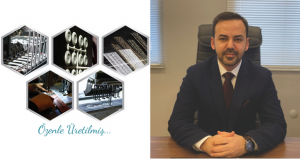Using antimicrobial textiles is an option anywhere where it is important to avoid infection by pathogens, so especially in the healthcare and personal care sectors. In those contexts, antimicrobial textiles may be used for bed linen, towels or the uniforms of doctors and care workers.
The Hohenstein Institute tests antimicrobial products and hygiene precautions for their effectiveness and benefit in the context of preventive health care and the fight against pathogens. BÖNNIGHEIM – According to a study by the European Centre for Disease Prevention and Control, every year about 3.2 million people fall ill with a hospital-acquired infection. For that reason, hygiene plays a very important role, both in healthcare institutions and in private households, in preventing illness and infection. Germs such as fungi or bacteria can survive on surfaces for several months. That is why it is important to take measures to combat them in order to break the chain of infection. Antimicrobial products can play an important role here. We talked to Prof. Höfer, Director of the Department of Hygiene, Environment and Medicine at the Hohenstein Institute, Bönnigheim, about the use and effectiveness of antimicrobial products. Prof. Höfer, at your institute you test the antimicrobial effect of products. What do your tests consist of? We test products that incorporate antimicrobial technologies for their compliance with international standards and certify their effectiveness on the basis of type testing. Textile and non-textile products with an antimicrobial function are tested and evaluated in standardised, independent test procedures. In addition to this kind of certification, we also offer our customers realistically designed tests so that the effectiveness of the product in question can be tested in use. In a number of different studies, we are also researching specific issues relating to antimicrobial effectiveness using specially adapted practical trials. Which sectors do the products come from that you test? The range of sectors from which products are tested is very wide. In general, we test all textiles, surfaces, consumer goods and other products which claim to contain substances that combat microorganisms. Products with an antimicrobial effect may be hygiene products, cleaning materials, outdoor products, functional textiles, workwear and personal protective equipment. However, domestic and wellness textiles, technical textiles, healthcare products, paints and varnishes, coatings and plastics may also contain antimicrobial substances. In what kind of areas can antimicrobial textiles be used? These products are often used in infection prevention, but also in industrial and domestic hygiene, or to reduce odors or prevent corrosion. Using antimicrobial textiles is an option anywhere where it is important to avoid infection by pathogens, so especially in the healthcare and personal care sectors. In those contexts, antimicrobial textiles may be used for bed-linen, towels or the uniforms of doctors and care workers. If surfaces and objects in communal facilities have an antimicrobial function, this can help reduce the transmission of pathogens by killing or deactivating the microorganisms. How is the antimicrobial effect achieved in products? In the case of antimicrobial textiles, these are normally products containing biocides. Biocides are substances that inhibit the growth of microorganisms or kill them. Such biocides include, for example, silver and copper, because silver ions and certain copper alloys are toxic to microorganisms. Products with an antibacterial effect kill bacteria. Antimycotic substances inhibit the growth of fungi, while antiviral substances have a deactivating effect on viruses. Textiles incorporating antimicrobial technologies can therefore certainly help combat bacteria, viruses and fungi. But don’t antimicrobial products that kill bacteria also damage our health? In order to help our customers assess the quality of an antimicrobial treatment and develop new products, we also offer them, in addition to the effectiveness tests, safety testing, for example on human skin flora. By skin flora, we mean the dense colonization of human skin with microorganisms. They play an important role in defending our bodies. We test whether strongly antibacterial products have a negative effect on the naturally occurring bacteria on the skin. Products which have no negative effects on the bacteria in healthy human skin flora are certified with the quality label “Skin flora-neutral”. According to the Society for Hospital Hygiene, 30,000 people die every year from hospital-acquired infections. The German Hospital Federation says that 2000-4500 of these infections are avoidable. Wouldn’t the use of antimicrobial textiles in the healthcare and care home sectors be of considerable benefit in preventing infections? The Hohenstein Institute is currently carrying out an independent research project to find out how effective antimicrobial textiles are in breaking infection chains in care situations. We are conducting this in cooperation with hospitals, care homes and the textile industry. In this way we can obtain realistic results from our study. What exactly is the purpose of this research project? The aim of the project is to examine in practice how antimicrobial textiles work in a healthcare context. We are paying particular attention to breaking infection chains and to the practicality of the textiles. We hope that the project will, firstly, provide scientific evidence for the use of antimicrobial textiles. Secondly, we hope to help improve public perception of the use and effectiveness of antimicrobial textiles. What do you see as the next steps, if your research project is successful, and whom will it benefit? If the field trials are successful, we will produce a matrix for the use of antimicrobial textiles in healthcare situations. This will indicate the kind of performance data for textiles that would suggest that antimicrobial products could be expected to be effective in a healthcare situation. If the transmission of bacteria can be significantly reduced by using antimicrobial textiles, that will be an additional hygiene benefit to supplement standard hygiene precautions. The application matrix will therefore be very important for the industry. With the help of this information, products can be developed and optimized. We are confident that, as a result, the acceptance and use of antimicrobial textiles in both healthcare institutions and domestic situations will increase. Do you also offer tests that could help prevent infection? Yes. Another area in which we offer testing is the monitoring and evaluation of textile hygiene. That includes testing the microbiological purity of laundry and the disinfecting and hygienic effectiveness of washing procedures, for example for the detergent industry. We also test and assess the hygiene measures taken in laundries’ technical facilities and the barrier function of uniforms and operating theatre textiles used in hospitals. Improved hygiene can prevent infection for both care workers and the people receiving care.
 SleepTech Magazine Mattress, Accessories, Machinery, Raw Materials
SleepTech Magazine Mattress, Accessories, Machinery, Raw Materials


